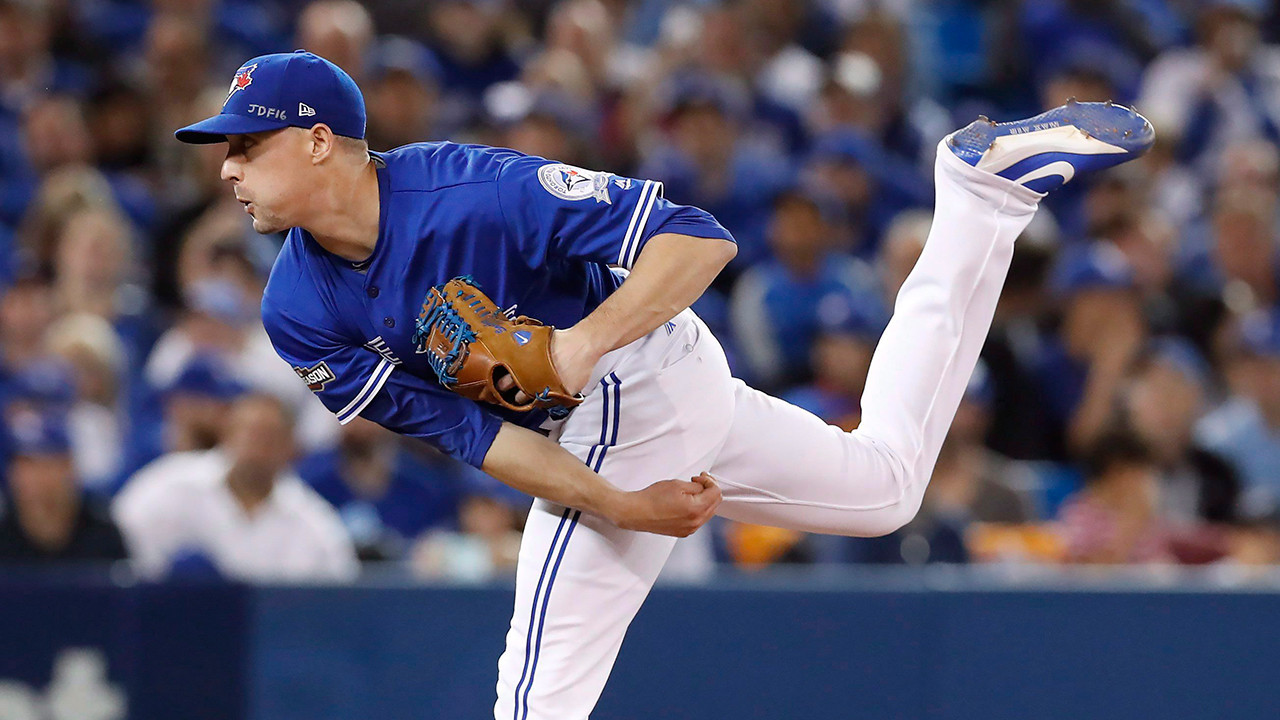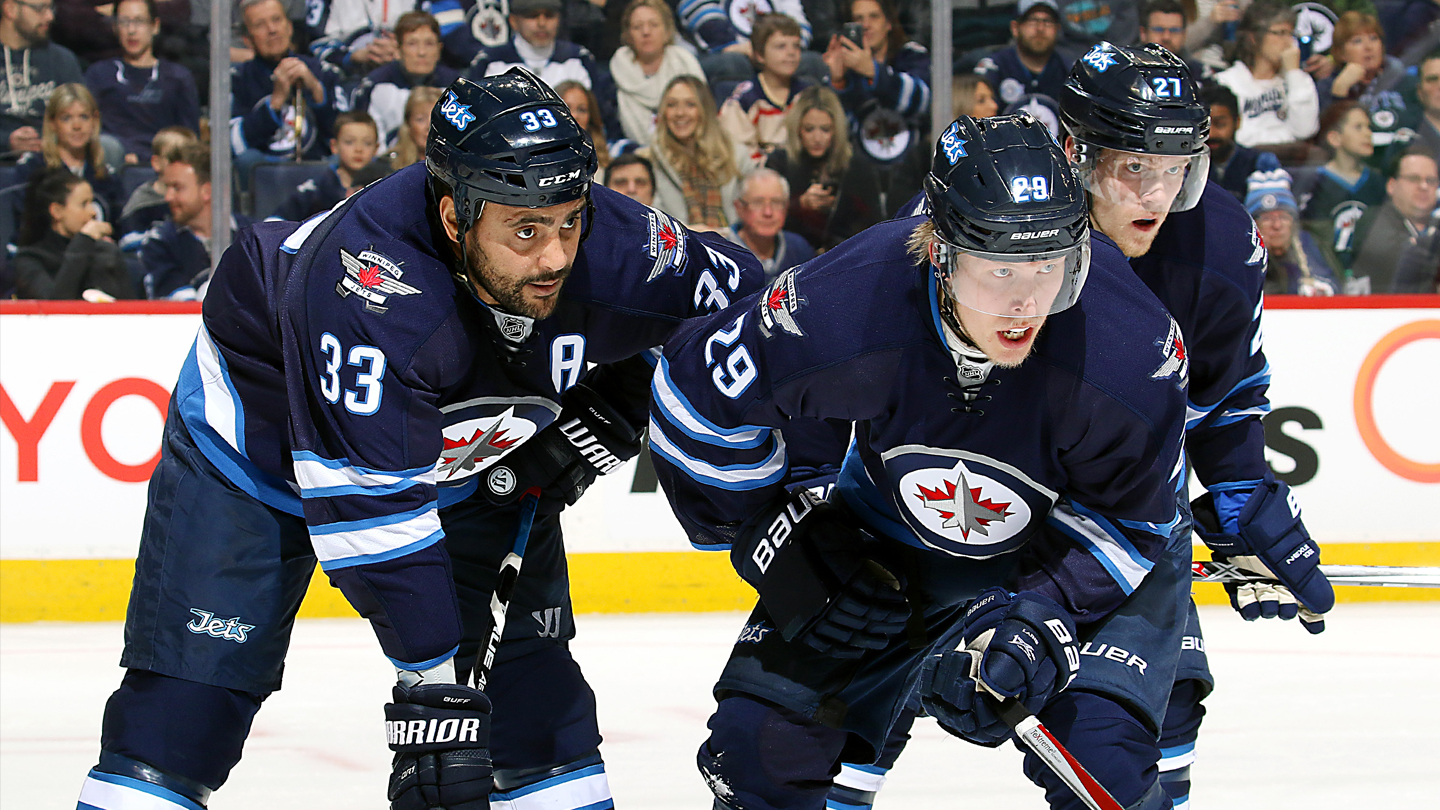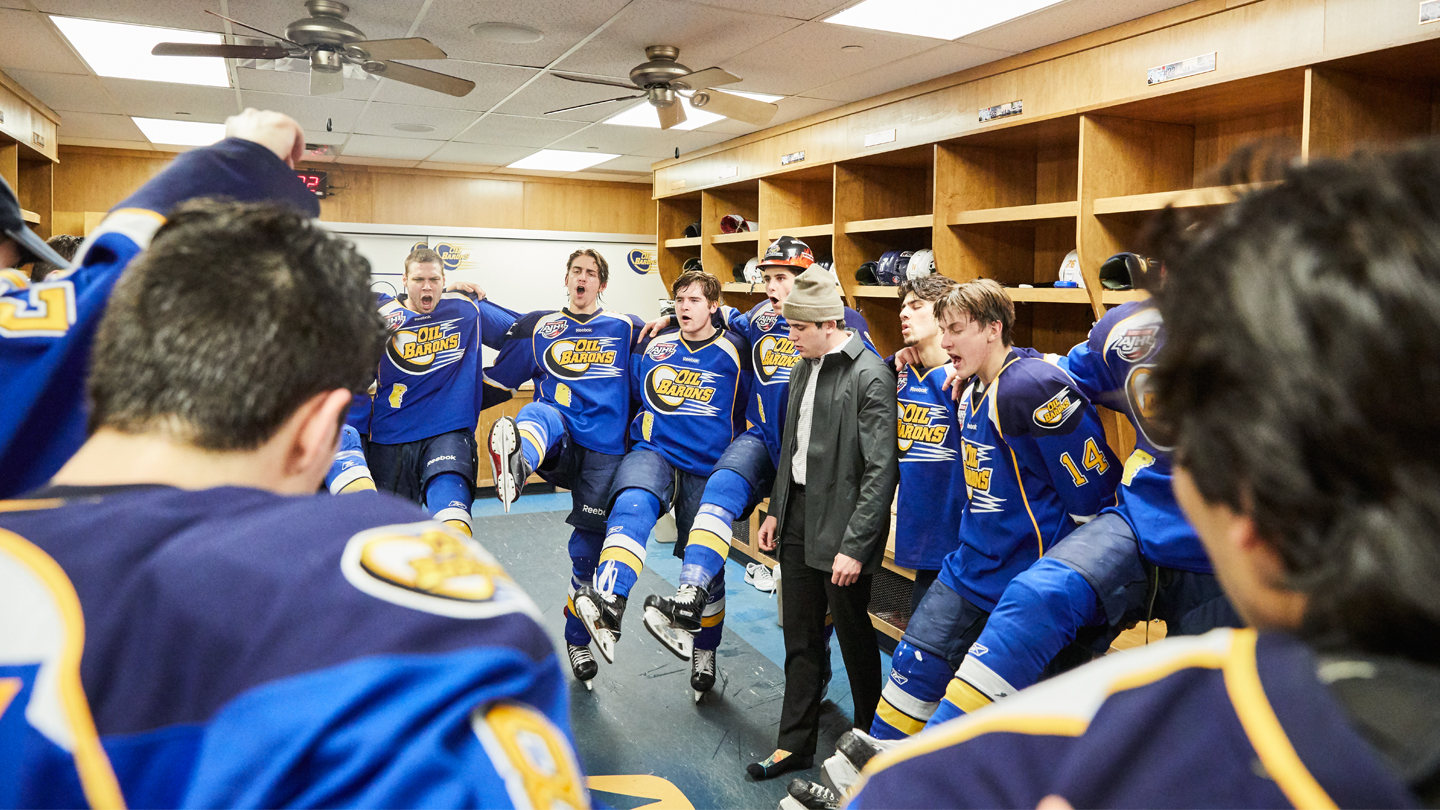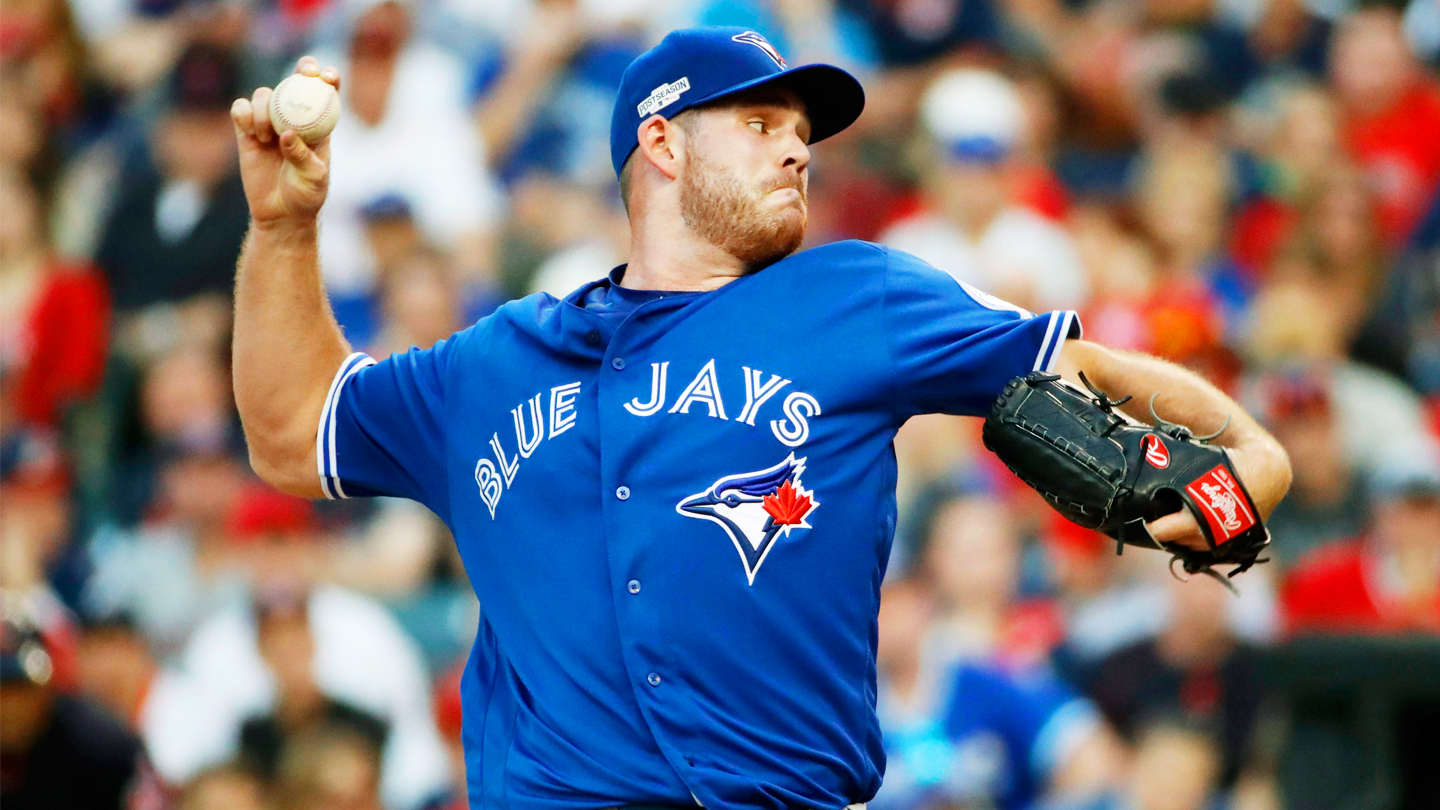Steve Pearce was that guy in the gym. You know the one. Get in there, colonize the squat rack, throw some chalk on the bar, load up as many plates as that sucker will hold, and bang out some reps. Real man stuff. Teeth clenched, ass tight, neck veins bulging. Let’s get those gains.
Alas, he is not that guy anymore. Working out early one morning at the Blue Jays’ Dunedin facility this spring, Pearce grabbed a kettlebell in one hand and simply walked in a straight line with it. Then, he got behind a weighted sled and pushed it slowly up and down a track, paying particular attention to his balance and form. After that, he picked the kettlebell back up, balanced on one leg, and bent forward at the waist, extending his other leg behind him as he completed a single-leg Romanian deadlift. He caught himself in the mirror afterwards and joked to his trainers that it didn’t even look like he’d done anything.
“I get here and they’re telling me about body weight exercises, all these precise movements, a bunch of flexibility and limbering stuff,” he says. “I’m like, ‘Yeah, but what about my pump?’”
There are no more pumps for Pearce, who signed with the Blue Jays this off-season after stops with five other major league teams. He’s found they do things a bit differently in Toronto. That’s thanks to the Blue Jays’ high performance department, an interdisciplinary collection of specialists covering everything from strength and conditioning to psychology. It’s an all-encompassing collective the Blue Jays hope will provide each and every player in the organization, from the teenager at the bottom of the minors to the $20-million asset playing every day on the big-league roster, the tools and resources they need to be at their best.
“In my experience, it’s completely unique to baseball. I’m doing exercises I’ve never done before,” Pearce says. “I feel like a fish out of water just trying to learn all the stuff that they do because it’s completely different.”
The department is run out of Dunedin by Angus Mugford, a sports psychologist who came to the Blue Jays from the revered IMG Academy where he spent a dozen years working with thousands of student athletes and plenty of professionals from a variety of sports. Blue Jays president Mark Shapiro — working off a recommendation from Charlie Maher, one of the first doctors to introduce sports psychology into professional baseball — tasked Mugford with building the department from the ground up a little more than a year ago and has greenlit its further expansion in 2017. After a recent round of full-time hires this winter, the department now boasts a staff of 43 across all levels of the organization, including consultants. There are the specialists you’d expect, like physical therapists and strength trainers, and some more uncommon, like mental performance coaches and a postural specialist.
Mugford says the department is among the best-staffed in baseball, and may be the MLB frontrunner in sports science, although these things are tricky to quantify because every organization is structured differently and few teams reveal the full extent of the work they do. Regardless, there’s no denying the organization’s extensive investment in the area. Along with the recent round of hires, the Blue Jays poured more than $1-million into weight room renovations at Rogers Centre this winter. They have also made vast improvements to the stadium’s coaching and rehab facilities, a precursor to future renovations in Toronto and the dramatic improvements the club wants to make to its facilities in Dunedin as part of the proposed $81-million renovation project Shapiro has spent much of his Toronto tenure working on.

“I think there are a lot of teams that are trying to do some similar things. But I would say that there aren’t any better staffs out there,” Mugford says. “It’s a massive commitment and it’s a deliberate approach to training guys with every opportunity, tool and resource we can. Hopefully, all the hard work can translate to the athletes staying healthy and competing well and, ultimately, bringing the World Series back to Canada. That’s what everyone’s driving to.”
The department’s motto is “prepare, work, recover,” a mantra the team wants applied to every aspect of a player’s life, whether it’s performing on the field, working out in the weight room, eating in the dining hall or sitting in bed thinking about the game. Another mantra Mugford likes to use is “doing things on purpose, with purpose.” He admits these maxims are a little corny, but they reflect his department’s philosophy: that every Blue Jay is an individual with his own unique set of physical and mental needs, and that each athlete should be provided a tailored development plan specifically designed to help him reach his goals. Gone are the days of everyone on the team completing the same weight-lifting routine, eating the same food, receiving the same treatment, throwing the same number of bullpen pitches and taking the same amount of spring training at-bats to prepare for the season. Each player works within their own plan and there is a specific, deliberate reason for everything they do in preparation, work and recovery. Everything is on purpose with purpose.
“I think the players are really buying in,” Mugford says. “They are in the middle of it all. They’re understanding that we’re trying to help them be the best they can be. We’re trying to help them grow and develop constantly. They’ve responded really well to that.”
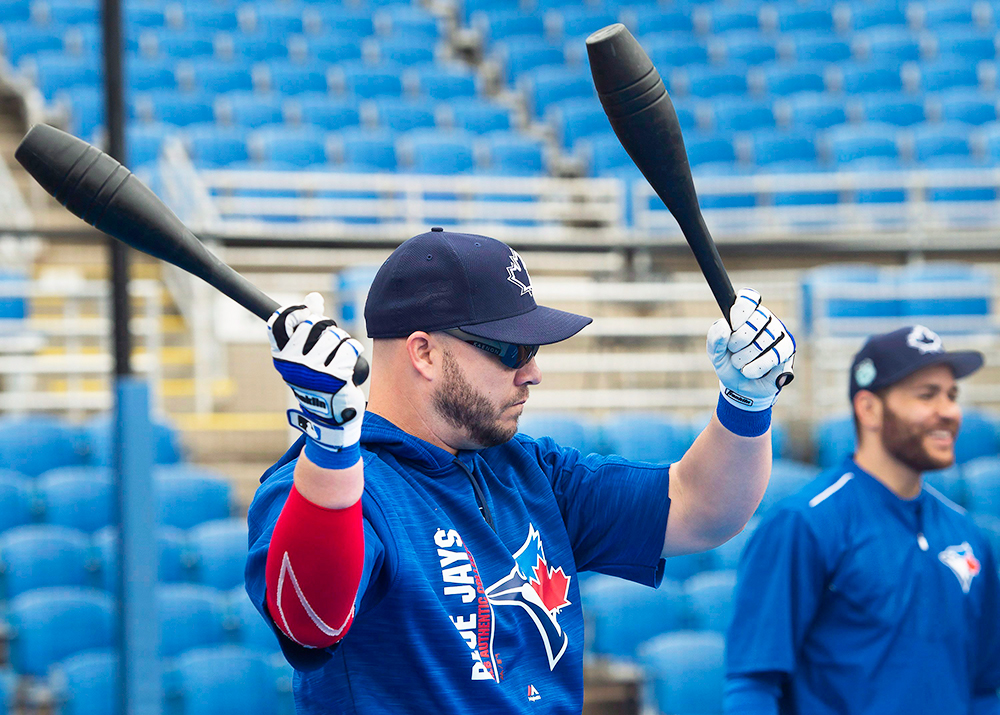
Another reason Mugford speaks in mottos is because much of the nuts and bolts of what his department does remains hidden. There is a bit of a sports science arms race occurring across major league baseball, and no organization wants to reveal too many secrets. Maintaining a competitive edge is paramount. “Certainly,” Mugford says, “the name ‘High Performance’ and some of the new things we’re doing can seem mysterious.”
But we do have some information. This winter’s new hires included two physical therapists, two dieticians, and a mental coach. Introducing the dieticians is especially exciting to Mugford, who sees a lot of untapped opportunity in the area. Performance nutrition has advanced leaps and bounds over the past decade and continues to evolve as nutritionists learn more about how what we eat affects what we do. And, perhaps more importantly, how we recover. An injured player’s consumption habits can be a crucial part of their rehab. For instance, anti-inflammatory foods like leafy green vegetables, nuts, fatty fish and olive oil can aid recovery and help get an injured player back on the field sooner.
The Blue Jays have revamped the food selection at Rogers Centre and each of their affiliates, offering primarily clean, wholesome choices to their players. They’ll also call ahead to visiting teams and ensure their clubhouses on the road are well stocked with healthy options. The high performance department also provides all of the organization’s players with guides to proper eating, portion size and when to time their meals and snacks, with the hopes that they will apply that knowledge to their eating habits away from the ballpark.
Fighting myths and misinformation is a big part of all this, as many athletes who enter the organization have been taught eating habits elsewhere that don’t line up with what the Blue Jays believe to be best. Mugford is hoping that the club’s new dieticians — Stephanie Wilson and Antonio Castillo — will combat that. “We’ve made a big commitment to that area,” Mugford says. “I feel it’s a real advantage for us that not many other teams are focusing on right now. But they will in time, because it’s such an obvious opportunity.”
Sports psychology has also been a big focus, and is an area where the Blue Jays see plenty of room for growth. We all know that baseball is a game predicated on failure, where a player who reaches base four times out of ten can go to the Hall of Fame. We also know that an MLB season is an absolute grind, with frequent travel, little time for recovery and significant performance demands on a daily basis. From a mental standpoint, it’s one of the more challenging sports you can play.
Mugford’s department currently employs three mental performance coaches, tasked with easing those realities at every level of the Blue Jays’ organization. They aim to teach players routines and exercises they can rely on to organize their thoughts, simplify their mental processes, and eliminate attitudes that are detrimental to their success. A slump at the plate or on the mound is going to wear on any ballplayer, but if that athlete can effectively think their way through their struggles they may be able to pull out of it quicker. Interestingly, much of the mental work the department does with Blue Jays players pertains to thinking less, not more. It’s believed that a quiet mind can be a crucial factor in helping athletes perform at their best.

Sleep is another critical area where the department is searching for openings. And the Blue Jays aren’t the only ones. The Tampa Bay Rays pushed spring training workouts back an hour this year, while the Boston Red Sox showed off plans for a sleep room at Fenway Park. The Blue Jays have looked into similar tactics, including adjusting flight times for road trips and providing players with tools to monitor the quality of their sleep. The organization also offers players information on better sleeping habits and even purposeful naps that can aid in recovery. “It’s a tactical advantage — it’s crucial to performance,” Mugford says. “Baseball is just not set up to be conducive to sleep, period. So, we’re actively searching for ways to maximize our players’ time in bed.”
And then, of course, there is the training. Mugford says one of the best compliments his department has received over the past year is the sheer number of players who chose to spend their winters in Dunedin, working with Blue Jays staff to improve their all-around abilities. It wasn’t only players recovering from off-season surgery, such as Pearce or Devon Travis. It was established major leaguers like Aaron Sanchez and Marcus Stroman looking to take the next step, as well as promising young prospects like Rowdy Tellez and Conner Greene looking to gain the edge they hope will get them to the majors.

Even referring to the winter as “the off-season” is becoming antiquated. The Blue Jays believe there is no off-season, only a pre-season. Ballplayers no longer check out completely from the game for four months and use spring training to get back in shape. The club wants its players buying into another of Mugford’s favourite mantras: you don’t have to be sick to get better. In addition to that, the organization has built what it believes is an elite, wide-ranging staff of performance experts who eliminate the need for players to hire outside coaches and consultants. Some of the team’s most prominent players, like Jose Bautista and Josh Donaldson, have sought out these resources from third parties in the past. “Players don’t have to go to some of these self-proclaimed gurus. They don’t have to find a dietician on the west coast and a strength coach elsewhere,” Mugford says. “We feel we have quality and quantity in our staff. It’s a real advantage for us.”
The six or so weeks of spring training are perhaps the most crucially important time of year for the department because every single member of the organization, both players and staff, is working out of Dunedin. It’s the best opportunity they’ll get to make a substantial, lasting impact. Once major- and minor-league seasons start, players and staff disperse across the continent — some even to Latin America — making it more challenging to monitor players’ progress and affect their performance. The Blue Jays organization has eight teams in three different countries, each of them playing games every day during the season. It’s a lot to keep up with.
That’s why this year, Mugford is focusing his efforts on improving communication between the various outposts of the organization and collaboration between coaching staffs, development coordinators and the high performance department. It’s one thing to have all the resources — it’s another to make them work together effectively and efficiently. Most of the department will remain based out of Dunedin, which is the team’s rehabilitation centre. But there will be a strength coach and trainer at each affiliate representing the department, and Mugford’s staff will often drop in as circumstances dictate.
Which brings us to Aaron Sanchez. The trials and tribulations of the 24-year-old’s workload last season is perhaps the highest-profile example of the high performance department’s mantras at work — and the department’s influence on decision making. After he won a starting job out of spring training, Blue Jays brass were publicly unequivocal that Sanchez would, at some point, be transitioned to a relief role in order to manage his innings. One of the best young arms in the game, Sanchez had reached 109.1 innings in an injury shortened 2015, and 133.1 innings the season prior. The club had little appetite to push him past 200 in 2016, believing it was in Sanchez’s best long-term interests to limit his innings increase.
But then Sanchez took the mound and forced the issue. He had an unbelievable start to the season, pitching to a 2.71 ERA in his first 21 starts, making the all-star team and building a strong case for Cy Young consideration. But when no one can hit you, your innings pile up. More than half of those 21 outings lasted seven innings or longer. By the end of July, he’d already set a new career high, and when the team acquired Francisco Liriano at the trade deadline, it informed Sanchez he would be making his planned move to the bullpen in order to protect his arm.

Of course, Sanchez had other ideas. With an ERA title in his sights, he argued he’d earned the right to continue starting based on his strict discipline and dedication to conditioning throughout the season. He had a point. He’d utilized every resource available to him through the high performance department, following a strict conditioning regimen and a daily eating plan that was broken down to the minute. The Blue Jays did not have overwhelming evidence suggesting Sanchez’s workload was a detriment or that he wasn’t prepared to finish the season as a starter. A deal was struck between the coaching staff, the front office, the high performance department and Sanchez himself to slow him down slightly but not remove him from the rotation altogether, as was originally planned. The Blue Jays went to a six-man rotation, and Sanchez’s final two months were carefully planned out with more time given between his outings. He made 11 starts from that point through the end of the post-season and finished the year as the American League leader in ERA with a new career-high of 203.2 innings pitched.
“Aaron is just an incredible professional. All credit goes to him for his dedication to his routine, his mind and his body,” Mugford says. “For somebody his age, it was exceptional. I think in a lot of ways he’s shown himself as a role model for how someone can really look after themselves. It was a special thing to see the success he had. That wasn’t an accident. It was his dedication.”
In the end, it was a brilliant example of how the Blue Jays hope the high performance department can impact their major-league team. The goal of the unit is to put the player at the centre of everything and have the many resources the Blue Jays provide operating in harmony around him. The club compares its many services to the spokes of a wheel, with the player being the hub.
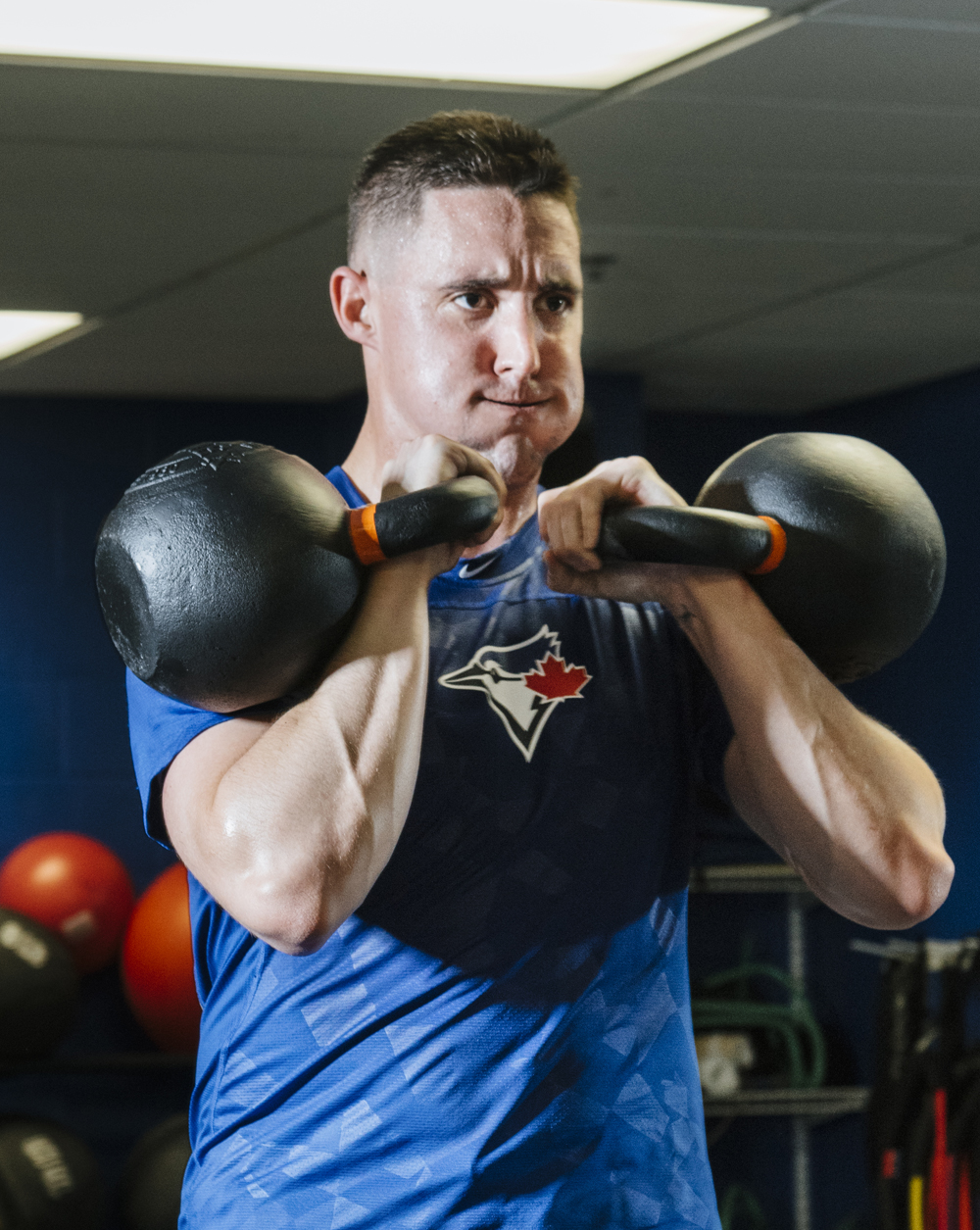
While Sanchez’s example shows the department is already making a clear impact at the big-league level, the team hopes the most substantial effects will come in a few years’ time, when 2016’s draft class is ready to enter the major leagues. That will be the first round of players who haven’t known a Blue Jays organization without the department — a group of athletes who have been exposed to its many tools at every step of their development. Ideally, the Blue Jays will get more out of their draft classes than they have in the past, feeding carefully groomed talent onto the major-league roster and decreasing the reliance on acquiring players from other organizations. In a lot of ways, the Blue Jays are building a ballplayer factory and tricking it out with the most modern machinery available.
“There are a lot of misnomers around sport science. It’s not about technology. It’s not about research articles. It’s about baseball. It’s about having evidence that something works,” Mugford says. “It’s about setting the players up for success. That includes the fuel they’re putting into their body, it includes their thoughts and their mindset, it includes their physical preparation and recovery. It’s about how those things come together and make them better able to perform on the field to help the team to win. That’s ultimately what we’re trying to do at the top level.”
But for now, the most apparent results you’ll see from the department will likely come with players like Pearce, who arrive from other organizations and are taken aback by the army of performance specialists they encounter. Still sweating from his latest bodyweight routine, Pearce laughs about how he used to work out. How he used to focus on beach muscles and looking swollen after a round of heavy deadlifts, squats and presses. He can’t believe he didn’t learn to work out this way until now.
“I feel a big difference. Just because the weights aren’t heavy doesn’t mean it’s not hard as heck,” he says. “These guys are just first class. They know their stuff. I’m still getting used to it. It’s challenging. But I look forward to it every day. Because it’s something new. And I like it.”

